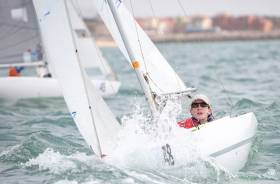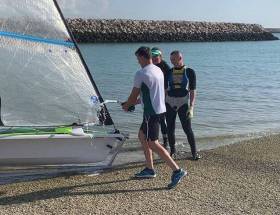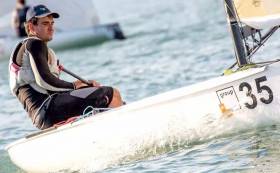Displaying items by tag: Cádiz
Nine countries took part in the 2019 Para World Sailing Championships last week in Puerto Sherry, near Cadiz in Spain, writes Irish competitor Patrick Hassett.
The Spaniards had a home advantage as tides were tricky and the Spanish Nationals had been held there three weeks ago.
Racing was held over four consecutive days with three 50-minute races each day. I was very happy with my performance at this level as I came either 13th or 15th (out of 18) in the majority of these races, with the final race of the series being my best (11th). My overall result was 15th.
Other competitors included two-time Paralympic gold medallist Damien Seguin (who finished first) and fellow Paralympians Antonio Squizzato and Bjornar Erikstad, who finished second and third respectively.
The weather in Puerto Sherry was amicable. However, the waves gave me more experience with the bilge pump than I had anticipated!
The course was a standard windward-leeward, with a gate as the leeward mark. The finish line was crossed with the boats on a run which was unusual.
The event allowed me to gain experience racing against a large fleet of 2.4mRs. I also got the opportunity to chat to sailors who had been sailing these boats for many years and pick up some tips and tricks from the veterans.
I thoroughly enjoyed the experience and look forward to continuing to improve my sailing.
A Toast For Annalise As Her Winter Training Begins In Cadiz
Mexican Laser sailor Yanic Gentry helped Annalise Murphy christen her new boat on its first day out on the water in Cadiz for winter training yesterday (Thursday 15 November).
The Olympic silver medalist announced earlier this month that she and her 49erFX partner Katie Tingle would be on the move to “somewhere warmer” after spending recent months getting to grips with the class on Dublin Bay — a situation that paused in the autumn due to Katie's arm injury.
While Katie is still on the mend, Annalise could not have have picked anywhere better than the Andalusian coast, near the gateway to the Mediterranean, to make every day count in her campaign to qualify for the 2020 Olympic Games in Tokyo.
Fionn Lyden Pulls Out of Finn Europeans Due To Illness
Illness has forced Balimore’s Fionn Lyden to withdraw from the Finn Europeans getting underway in Cadiz today, Friday 9 March.
Irish Sailing’s James O’Callaghan confirmed the news as sailors from across Europe take to the waters of Andalusia ahead of the first races next Monday.
Lyden’s illness means that Oisin McClelland of Donaghadee Sailing Club will be the only Irish representative among the near 100-strong field as he progresses his Tokyo 2020 campaign.
Afloat.ie has more on the first big test of the year for Finn sailors gearing up for the Olympic qualifier this summer in Denmark.
Entry List Announced for Tall Ships Races 2012
#TALL SHIPS - Eighteen vessels are on the entry list for the 2012 Tall Ships Races which are set to conclude in Dublin Port next August.
The list is dominated by British entries, with all nine UK tall ships expected to sail the third and final leg from A Coruña in northern Spain to Dublin.
Tall ships from Russia, Poland, France, Ecuador, Bulgaria, Latvia, Estonia and Belgium will also be in the fray when Ireland's capital hosts the final port of call for the 2012 races, presented by Szczecin in Poland and organised by Sail Training International - a charity established to harness sail training to develop and educate young people regardless of nationality, culture, religion, gender or social background.
The first leg of the 2012 races kicks off in Saint-Malo, France on 7 July with ships racing to Lisbon in Portugal (till 21 July); Cádiz in southern Spain (21-28 July) and A Coruña (28 July-12 August) before the final leg.
Dublin will be hosting the Tall Ships Races for the first time since 1998. Earlier this year Eamonn O’Reilly, CEO of Dublin Port Company, said he was “delighted to welcome the Tall Ships Races to Dublin Port" in 2012.
Since the announcement the port has already played host to the British tall ship Tenacious and the Norwegian vessel S/S Statsraad Lehmkuhl.
From Thursday 23 to Sunday 26 August 2012 as many as 100 ships are expected to arrive in the port and Docklands area for an event that includes a four-day festival programme of music, food and fashion showcases, markets, street theatre, water sport and water-based activities.
The weekend will also feature activities unique to the races including a crew parade, prize-giving event and a parade of sail.
Are you looking to get involved in Dublin's hosting of the Tall Ships Races? Check out the following links:
Become a trainee www.dublintallships.ie/trainees/
Take part as a volunteer www.dublintallships.ie/volunteers/
For further information see www.dublintallships.ie or e-mail [email protected]
Entry List for the Tall Ships Races 2012:
Akela (Russia)
Black Diamond Of Durham (UK)
Dar Mlodziezy (Poland)
Etoile Polaire (France)
Guayas (Ecuador)
Johanna Lucretia (UK)
John Laing (UK)
Kaliakra (Bulgaria)
Lord Nelson (UK)
Maybe (UK)
Moosk (UK)
Pelican Of London (UK)
Pogoria (Poland)
Rona II (UK)
Spaniel (Latvia)
St Iv (Estonia)
Thermopylae Clipper (UK)
Tomidi (Belgium)































































